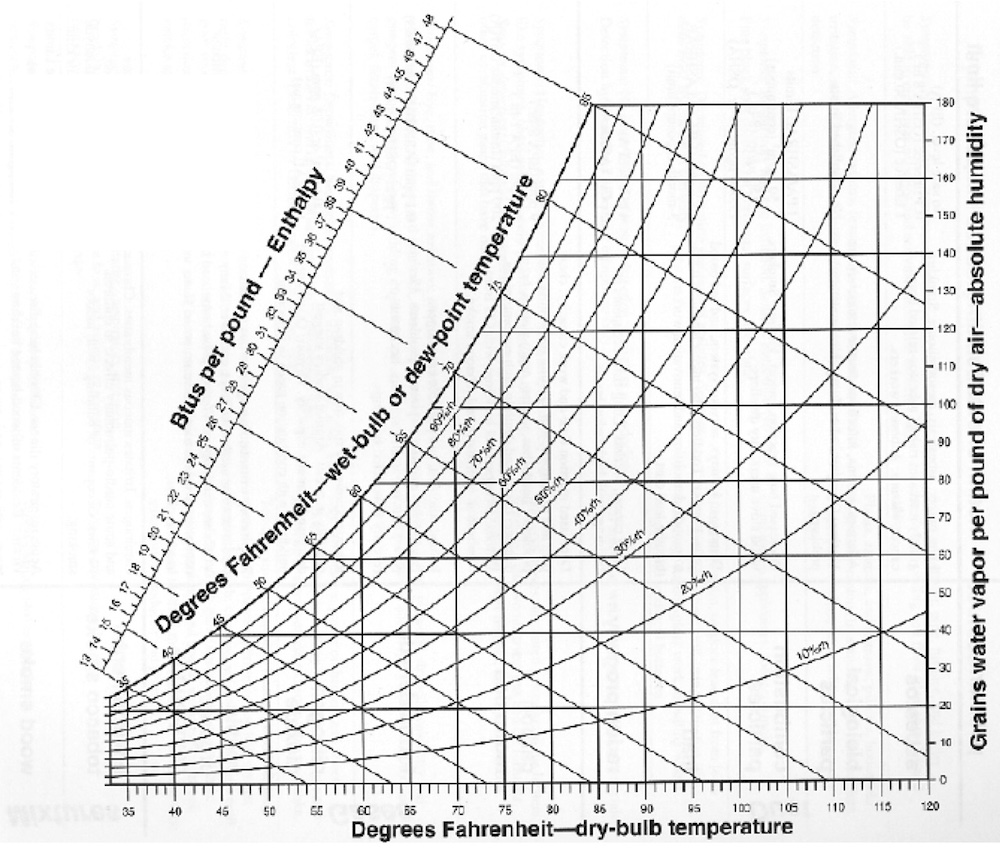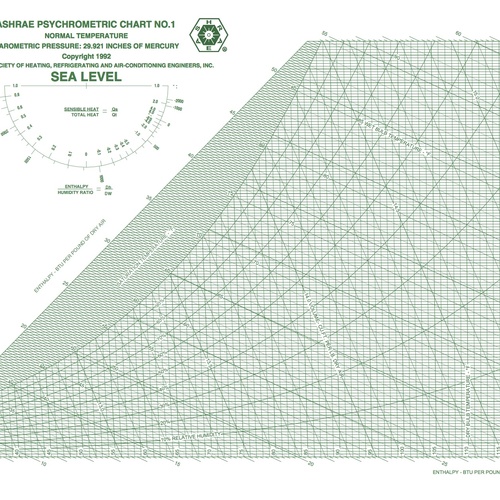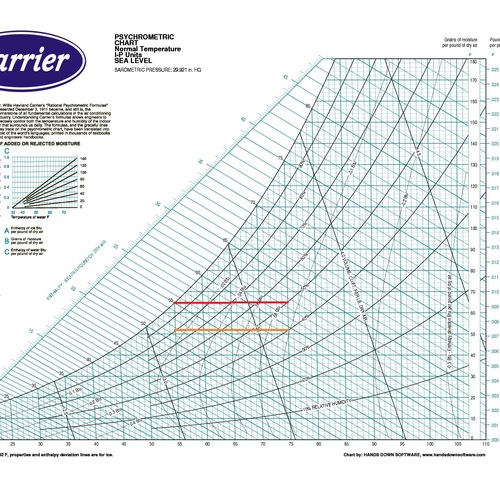
So you think you understand psychrometrics, eh? OK then. Let’s do a little quiz today and test your psychrometric knowledge. These questions include some basic stuff and some more complicated stuff about the subject, but you don’t need to use math to answer them. It’s not the same as playing Psychrometric Chart Simon Says (photo above), but it’s a good exercise.
Psychrometric fundamentals
Before we start, though, let me bring the uninitiated into the fold with some basics about psychrometrics. First, let’s define the term:
Psychrometrics – the science that involves the properties of moist air (a mixture of dry air and water vapor) and the processes (meteorological, air conditioning, drying, humidification, dehumidification, agricultural soil evaporation) in which the temperature and/or the water vapor content of the mixture are changed.
That definition is from the bible of psychrometrics, Understanding Psychrometrics by Donald Gatley. It’s a great book that covers the whole subject, including history, terminology, and more. It goes pretty deep and has a lot of math, so it’s not for everyone. I wrote a little series on psychrometrics a while back, and that might be a good way to go deeper.
In the old days, engineers used to design HVAC systems by using a psychrometric chart (below). It’s a visual representation of the relationships of the psychrometric variables. Nowadays, the chart is more of an educational tool. Engineers use computer programs or apps to do numerical work in psychrometrics.

You can use the chart shown above as an aid to answering the questions below. Also, one of the questions below relies on a numbering scheme for the surfaces in a double pane window. That system also applies to a single pane window with a storm window. Here’s the scheme:
- Outer surface of outer pane (You can touch it from outside the house.)
- Inner surface of outer pane (between the two panes but on the outer pane)
- Outer surface of inner pane (between the two panes but on the inner pane)
- Inner surface of inner pane (You can touch it from inside the house.)
Ready to see how well you understand psychrometrics? Here we go.
A psychrometric quiz
1. On a cold rainy day, outdoor air leaks into a house and warms up to room temperature. What happens to the indoor relative humidity?
2. A double-pane window develops a leak that allows humid air to get into the space between the panes. Which surface is most likely to have condensation on it in summer? (Use the numbering scheme above.)
3. You walk outside and your glasses fog up. What time of year is it?
4. Your car’s windshield fogs up on the inside in winter. What’s the best way to clear it?
5. Can outdoor air in the southeastern U.S. dry out a vented crawlspace in the summer?
6. What happens to the dew point temperature when the dry bulb temperature increases while the water vapor concentration remains constant?
7. Can relative humidity go higher than 100%?
8. An air conditioner in Miami, Florida, cools and dehumidifies the air. What do you know about the relative humidity of the air right after it comes through the cooling coil?
9. What happens to the dew point temperature when the relative humidity stays constant while the dry bulb temperature increases?
10. Have you or anyone you know experienced conditions of 100°F (38°C) and 90% relative humidity?
The answers
You’re not looking ahead without putting forth a good effort to answer those questions, are you? If so, go back and write down some answers.
I’ll wait.
Done?
Well, go do that last one. Don’t you really want to understand psychrometrics?
I’m giving you plenty of opportunity to avoid accidentally seeing the answers here.
OK, here you go.
1. It drops. For example, 32°F (0°C) outdoor air at 100% relative humidity will drop to ~20% when heated to 70°F (21°C). See more in my article on cold air and humidity.
2. Surface 3. If the indoors is air conditioned, it’s going to stay consistently cooler than the outer pane of glass.
3. Summer in a humid climate. Humid outdoor air meets cool glasses.
4. Blow heated air at the windshield with the air conditioner running and the system set to fresh air, not recirculate. For even more dehumidification, open the car windows. See my article on that topic for full details.
5. Nope. It often leads to higher relative humidity. Details here.
6. If the water vapor concentration doesn’t change, the dew point also doesn’t change. (Well, I didn’t say anything about barometric pressure, so we’re assuming it’s constant. If it changes, too, then the dew point temperature can change.)
7. Yep. If there’s nothing for the water vapor to condense onto, you can get supersaturated air at higher than 100% relative humidity.
8. It’s going to be very high, maybe even close to 100%. But it dries out the indoor air because it has a lower dew point. When it mixes with the rest of the indoor air and warms up to room temperature, the relative humidity drops. See the answer for question 1.
9. To maintain constant relative humidity at higher temperatures, you have to have more water vapor in the air. That causes the dew point to increase.
10. Not on Earth in any outdoor weather conditions ever recorded. The dew point temperature for those conditions would be 96.5°F (36°C). The highest recorded dew point is 95°F (35°C). More on that topic here, with US dew point records, too. Now, it’s possible you or your friends could experience a dew point temperature higher than the world record, but you’d be in a sauna.
There you have it. If you understand psychrometrics, you should have gotten at least 7 out of 10 right.
________________________________________________________________________
Allison A. Bailes III, PhD is a speaker, writer, building science consultant, and the founder of Energy Vanguard in Decatur, Georgia. He has a doctorate in physics and is the author of a bestselling book on building science. He also writes the Energy Vanguard Blog. For more updates, you can subscribe to our newsletter and follow him on LinkedIn. Images courtesy of the author.
Weekly Newsletter
Get building science and energy efficiency advice, plus special offers, in your inbox.















17 Comments
Allison,
I had to take the quiz before reading the article (nerd moment here), and I haven't looked at the correct answers yet. Also not sure if you meant folks to post answers here or not, but since I am first, here goes:
A psychrometric quiz
1. On a cold rainy day, outdoor air leaks into a house and warms up to room temperature. What happens to the indoor relative humidity?
As air warms up, rh goes down.
2 A double-pane window develops a leak that allows humid air to get into the space between the panes. Which surface is most likely to have condensation on it in summer? (Use the numbering scheme above.)
Surface 3.
3 You walk outside and your glasses fog up. What time of year is it?
Usually summer, but possible anytime the temp of the glasses is below dew point temperature of the outside air
4 Your car’s windshield fogs up on the inside in winter. What’s the best way to clear it?
Warm the windshield to a temperature above the dew point temperature, crack car windows to allow drier outside air in.
5 Can outdoor air in the southeastern U.S. dry out a vented crawlspace in the summer?
Not very likely
6 What happens to the dew point temperature when the dry bulb temperature increases while the water vapor concentration remains constant?
Dew point is dependent on water vapor concentration not temperature, so no change
7 Can relative humidity go higher than 100%?
Yes, but only when under pressure
8 An air conditioner in Miami, Florida, cools and dehumidifies the air. What do you know about the relative humidity of the air right after it comes through the cooling coil?
It increases because as temperature goes down rh goes up
9 What happens to the dew point temperature when the relative humidity stays constant while the dry bulb temperature increases?
Dew point goes up because in order for dry temp to rise and rh remain unchanged, there would need to be an increase in moisture level and that would result in higher dew point temperature
10 Have you or anyone you know experienced conditions of 100°F (38°C) and 90% relative humidity?
Not that I am aware of
Allison,
I just squeaked by with 7 out of 10.
Didn't do as well as I thought I would have. I would have done better if I had answered the questions I thought you were asking instead of the ones you asked
E.g. #5. Sure it can, but usually not. So the answer seems to be 'yes'? But it's actually 'nope'
And #10-- a sauna came straight to mind. While I haven't ever brought my sling psychrometer to the sauna with me, maybe next time I will! Experiencing those conditions is plausibly quite common. But I realize now that wasn't the question you were asking.
And #2. I guessed differently, but I assumed no AC, and that was where I went wrong.
I've gotta study up next time!
Question 1 asks what happens to the relative humidity of the indoor air, not the infiltrated outside air. The cold moist outside air mixing with the warm indoor air will raise the indoor air relative humidity. The mixture condition will be somewhere along the line between the two points - indoors say at 70F, 50% RH, outdoor say at 35F, 90RH. Any point between those is at a RH above 50%., even if mixed condition is just a smidgen off the room air condition.
PeteMossPNW,
Maybe you are making a subtler point I'm not getting, but we are talking about RH. Once the outside air is heated, its relative humidity will be well below that of the indoor air - because the "relative" in RH refers to relative to its temperature.
I fully understand. Once the mixed air is heated back 70 the RH will drop.
Yours and Allison’s point, and the take away for the readers should be that cold air even when really “wet” is typically “drier” than the indoor air in our buildings ( and as question 5 drives home, warm air can be wetter).
The key is the vertical axis on the psych chart - the absolute humidity or its proxy the dew point temperature. Compare dew points to see which air is “wetter”.
I think my comment was too subtle and applies to, say, the mixed air plenum in an air handler before being heated - not really applicable to our heated homes.
If I understand, you're saying, in other words:
Cold, moist (in terms of RH) air mixed with warm, dry (RH) air will yield a condition between the two-- in terms of temperature and RH both. Warmer than the cold air and colder than the warm air prior to mixing. Likewise, in terms of RH, wetter than the dry air and dryer than the wet air.
It takes energy to raise the temperature of the mixed air masses, and without that addition of enegy, the RH will have been raised.
I would point out though that the question does explicitly state, "and warms up to room temperature." Which to me implies the necessary energy has been added to maintain a steady state temp, thus RH will be lowered.
I also think mixing must be assumed, i.e. 'exterior air' that has infiltrated is now part of the room 'interior air.' If heat is being transfered, so is moisture, and vice versa.
"Cold, moist (in terms of RH) air mixed with warm, dry (RH) air will yield a condition between the two-- in terms of temperature and RH both."
I'm actually now wondering if this is true.
The answer to question 8 of this quiz would seem to suggest otherwise. How would AC ever lower RH if this were true?
The answer to Question 8 is a bit odd though in that it says "When it mixes with the rest of the indoor air and warms up to room temperature, the relative humidity drops. "
Warms up to room temperature? But it's air conditioning. It's job is to lower room temperature. So it doesn't 'warm up to room temperature' it mixes with the air to create a new temperature.
Thus the question. When two parcels of air mix and aren't heated, is the RH always 'in between' the RH of the two parcels, or can the RH be lower than either separate parcel pre mixing?
The problem is that "cool," "warm," "dry," and "moist" aren't defined.
"Cool moist" air may or may not have a higher dew point than "warm dry" air.
They're relative terms and thus don't need further definition.
The question is can any parcel of air that is relatively cooler and with a higher RH mix with a parcel that is relatively warmer with a lower RH and produce a result that has a lower RH than either beginning separate parcel. Without heating the mix.
I have completely stopped using the psychrometric chart.
Instead, I just calculate RH, absolute humidity and dew points directly. It's easy if you have a chart of saturation moisture content by temperature. If you know the temperature and relative humidity, absolute humidity is just the saturation moisture content at that temperature times the relative humidity. Dew point is the temperature at which that moisture content would be saturation.
For instance, if it's 70F and 50% RH, at 70F saturation is 110.7 grains per pound. So at 50% RH you're at half of that, 55.3 grains per pound. At 51F saturation is 55.7, and at 50F it's 53.6, so your dew point is between 50 and 51 F.
I have a spreadsheet at: https://docs.google.com/spreadsheets/d/1LONsi_1Fb6u4PsDQjzrbHn7ToX7yQHHEvr5OxExVwQc/edit?usp=sharing
That I use for these calculations. There is a tab "Temp and air moisture content" that has the underlying data.
This is great. Thank you for sharing this. Just to make sure I'm understanding it correctly, the constant in the latent cooling formula (0.68) is derived from the heat of vaporization of water and the density of dry air?
Correct. It's not correcting for the density change in air with temperature.
DC,
What do you use the calculations for?
For modeling the performance of a cooling coil -- how much dehumidification will it do, how many CFM do you need to get a certain number of BTU's.
DC,
Ah makes sense. It's something I've never done. If our current weather trends hold up, it's probably something I should learn.
I'd like to offer a different way of looking at it. Let's assume that indoor air is comfortable at 70F with relative humidity between 40% and 60%. I've attached a chart of outdoor temperature vs humidity with two lines. The region above the orange line is where the outdoor air is too humid; to be comfortable it needs to be dehumidified. The region below the blue line is where the outdoor air is too dry, it needs to be humidified. (Note that this is a simplistic analysis; the residents are going to be constantly introducing humidity into the building. It's not possible to model that in a general way, but both lines will be moved somewhat to the left.)
Further assume that air brought in needs to be heated if it's below 67F and cooled if it's above 78F, so imagine that chart has two vertical lines, one at 67 and one at 78. To the left of the 67 line is the heating region, to the right of the 78 line is the cooling region. So you get nine regions:
* Cool and dehumidify
* Cool and humidify
* Just cool
* Heat and dehumidify
* Head and humidify
* Just heat
* Just dehumidify
* Just humidify
* Do nothing
Log in or create an account to post a comment.
Sign up Log in